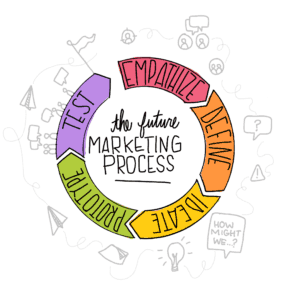What is design thinking?
“Design thinking is a human-centered approach to innovation that draws from the designer’s toolkit to integrate the needs of people, the possibilities of technology, and the requirements for business success.” — Tim Brown, CEO of IDEO
The word “design” has been tossed around and casually used in a myriad of ways over the years. As such, the ways in which each person interprets the word widely varies. Most commonly, it is associated with graphic designers; these amazingly talented and creative people can put many seemingly unrelated pieces together and a bring a concept to life. However, design has the potential to be so much more than that — it is also about applying the principles of design to the way people work. By reframing how we define design and viewing it as a process, action, or verb, it becomes a powerful tool to solve problems, discover opportunities, align people, and drive businesses forward.
Design thinking could be defined as a collective of principles. For example, Stanford’s d.school’s design thinking pillars are empathize, define, ideate, prototype, and test. Whereas IDEO defines design thinking into these phases: gather information, generate ideas, make ideas tangible, and share the story.
Although design thinking can be framed and applied in various ways, fundamentally it is rooted in the same core values:
- Solves problems by putting the end-user at the center of the process
- Embraces radical collaboration by building multidisciplinary teams
- Seeks to understand the needs and challenges of the people, process, or experience
- Explores potential solutions through prototyping
- Solicits feedback from real users to iterate and improve
- Views failing fast and often as an opportunity to learn
- Recognizes that design should achieve purpose and business goals
Design thinking impacts the way we do business.
“It’s really hard to design products by focus groups. A lot of times, people don’t know what they want until you show it to them.” — Steve Jobs
Design thinking facilitates new ways for organizations to explore and test assumptions, embrace uncertainty, think holistically, and exponentially transform the ways they develop strategy, services, and products. Due to the intrinsically human-centered approach, the end-user’s behavior, thinking, habits, motivations, and ethnographic backgrounds are taken into consideration at the beginning of development — allowing companies to create products and services that fill a gap or solve a real problem. This paradigm shift provides an untethered opportunity for organizations to disrupt industries, gain market share, and drive business growth.
Marketers are ahead of the curve, but we need to do more.
“The aim of marketing is to know and understand the customer so well the product or service fits him and sells itself.” — Peter Drucker
As marketers, elements of design thinking are already inherently part of our process. To create an engaging campaign, design a user-centered and beautiful website, or successfully launch a new product, we must first understand what our users want and need. Through research, planning, implementing, measuring, and optimizing, we start to understand users’ specific issues and urgencies.

However, we have the opportunity to do so much more. To create truly remarkable experiences that exponentially drive awareness, engagement, leads, and sales, we must unearth and understand deeper customer insights that are inclusive of demographic, psychographic, ethnographic, and behavioral data. Our teams need to become more diverse, and we MUST be okay with failing fast.
The future state of marketing.
“We spend a lot of time designing the bridge, but not enough time thinking about the people who are crossing it.” — Dr. Prabhjot Singh
Customers expect great content; they’re bombarded with nearly 5,000 ads per day. By integrating design thinking into your content creation, team collaboration, and strategy ideation, you can move the needle forward for your clients, produce work that stands out from the crowd, and better understand the real needs of your customers.
By fully embracing and embedding design thinking in our work we can shift the status quo, explore new ways to combat marketing challenges, and reach customers where they are with the information they need.
Join us.
We are facilitating a panel discussion on Design Thinking & Marketing at Portland State University, Center for Excellence and Professional Education on June 14. The event is free and will offer expert insight into how to position your brand with a UX-focused approach. Hope to see you there!



